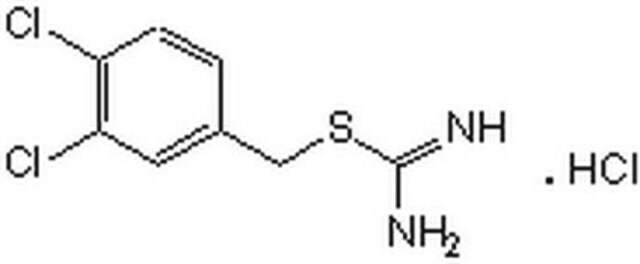SML0471
A22 hydrochloride
≥95% (HPLC)
Synonim(y):
MreB Perturbing Compound A22, S-(3,4-Dichlorobenzyl)isothiourea hydrochloride
About This Item
Polecane produkty
Próba
≥95% (HPLC)
Postać
powder
warunki przechowywania
desiccated
kolor
white to beige
rozpuszczalność
H2O: 2 mg/mL (clear solution, warmed)
temp. przechowywania
2-8°C
ciąg SMILES
Cl.NC(=N)SCc1ccc(Cl)c(Cl)c1
InChI
1S/C8H8Cl2N2S.ClH/c9-6-2-1-5(3-7(6)10)4-13-8(11)12;/h1-3H,4H2,(H3,11,12);1H
Klucz InChI
VBJNMXMOMSWRDV-UHFFFAOYSA-N
Zastosowanie
Działania biochem./fizjol.
Kod klasy składowania
11 - Combustible Solids
Klasa zagrożenia wodnego (WGK)
WGK 3
Temperatura zapłonu (°F)
Not applicable
Temperatura zapłonu (°C)
Not applicable
Certyfikaty analizy (CoA)
Poszukaj Certyfikaty analizy (CoA), wpisując numer partii/serii produktów. Numery serii i partii można znaleźć na etykiecie produktu po słowach „seria” lub „partia”.
Masz już ten produkt?
Dokumenty związane z niedawno zakupionymi produktami zostały zamieszczone w Bibliotece dokumentów.
Nasz zespół naukowców ma doświadczenie we wszystkich obszarach badań, w tym w naukach przyrodniczych, materiałoznawstwie, syntezie chemicznej, chromatografii, analityce i wielu innych dziedzinach.
Skontaktuj się z zespołem ds. pomocy technicznej






